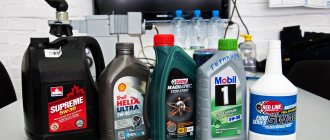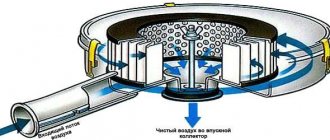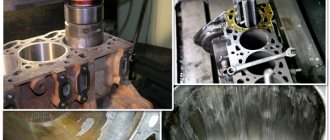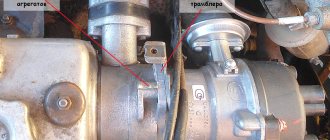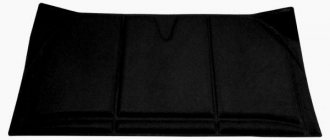How and with what to insulate a car engine in winter
With the onset of winter and sub-zero temperatures, many car enthusiasts who value the engine of their car begin, willy-nilly, to think about insulation.
Insulating a car engine in winter So, first, let’s figure out whether it is necessary to close the cooling radiator? In most cases, this should not be done, since there is no forced cooling on modern cars, and the fan turns on only when necessary at the command of the sensor. Of course, when driving, the radiator and engine compartment are covered from the flow of oncoming cold air and the engine warms up a little faster. But as soon as the temperature outside rises a little, or stops in a traffic jam, the temperature rises sharply and the engine can overheat. It is highly not recommended for inexperienced drivers to close the radiator, who practically do not pay attention to the coolant temperature sensor. Experienced drivers who still use this method can be advised to leave at least some part of the radiator open and constantly monitor the temperature sensor.
Another safer and quite effective method is to cover the engine from above. Insulation in this way retains heat in the engine compartment when parked and the engine does not cool down to street temperature for up to 3-4 hours. Whereas without insulation the engine cools down completely in 2 hours. The engine warm-up time is also slightly reduced.
How to cover the engine? Under no circumstances should old peacoats or sweatshirts be placed on the engine. Sleeves and corners of clothing may get caught on the exhaust manifold or alternator belt. The temperature of the exhaust manifold is very high, and the batting with which the clothes are filled smolders and burns very well. Attention , this method is very fire hazardous.
Construction foam insulation also burns very well, and the foil can short-circuit the battery terminals or some exposed wire to ground. Which can also lead to a fire. With extreme caution, construction insulation materials can only be used by securing them to the inside of the hood lid. In this case, be sure to take measures so that the foil does not touch the battery. This method is very cheap, but it is also minimally effective. The engine will remain warm for a maximum of three hours.
The most effective and safe way is insulation with felt (felt). It can be bought in VDPO (volunteer fire department) stores. Felt is sold by linear meters. The width of the roll is about one and a half meters, which is quite enough. It’s worth buying about two meters and folding it in two layers when insulating. The felt is not corroded by any filling liquids and is fireproof. But when laying it, you should also pay attention so that the fabric does not touch the exhaust manifold and rotating elements. The cost of the felt is approximately 200 - 300 rubles per 2 meters. A covered engine will not cool down to outside temperature for approximately four to five hours.
Another good material is “car blanket”, used specifically for these purposes. Some manufacturers offer models for specific car brands with embroidered edges for the hood lock, neck of the washer fluid reservoir, etc. The cost of such a blanket is 700 - 1500 rubles. The material is based on metal or stone foamed at very high temperatures. The material is not flammable and is not affected by brake fluids, electrolytes or other chemically active substances. Under such a blanket the engine will remain warm for up to five hours.
So, the main methods of insulating a car engine were considered. Easy starts for you and green lights at all traffic lights! Bon Voyage!
Video of proper engine insulation in winter.
How to insulate a diesel engine with your own hands
A diesel engine is “colder” than a gasoline engine and therefore requires more attention in winter. The main problem with diesel engines in winter is fuel freezing. Therefore, the first thing to do is to insulate the fuel pipeline. To do this you will need foam polyethylene, a stapler and silicone. A strip is cut out of polyethylene, which is wrapped around the fuel pipe and secured with a stapler. Along the edges the insulation is fixed with silicone. The next step is to insulate the radiator. This can be done using the same polyethylene foam. It is cut to the size of the radiator and placed in two layers between the radiator grille and the radiator.
To improve the insulation effect, it is recommended to cover the car engine with a blanket. Previously, car enthusiasts came up with different insulation materials for these purposes, but such a need has disappeared. On the auto accessories market, you can easily find a car blanket that is designed specifically for these purposes and is the safest solution.
Warming a gasoline engine
The insulation of a gasoline engine is practically no different from a diesel engine. The only thing that does not have to be insulated is the fuel pipeline.
How to insulate a VAZ 2110 engine
Very often, with the onset of winter, before leaving the open parking lot, drivers of a VAZ 2110 car have to warm up their car. This leads to additional gas consumption and time wastage. To prevent these losses from occurring, you need to take care of insulating the car engine.
To insulate the VAZ 2110 engine you will need a special heat insulator, sound insulator, felt, foam rubber, glue, wire and scissors.
Insulating the engine of a VAZ 2110 car must be done only in severe frost. If the temperature is expected to drop to -10 degrees, you should insert a piece of cardboard in front of the radiator when traveling outside the city and on long trips. In addition to heating the engine, you can ensure that even warmer air enters the cabin.
The safest way to insulate the engine is to install a special insulation on the car. To do this, you need to visit a service station or a special installation center, where they will quickly and efficiently install the insulation under the hood of the vehicle.
In case of independent insulation, you should use a special heat insulator - tiviplen, which includes three layers. First there is a front PVC coating, then polyethylene foam, then an adhesive layer on top. This material also has different thicknesses, 4, 8, and 15 mm. You need to take measurements, make careful markings and cut out the desired shape. Next, you need to apply a layer of adhesive on the lid and press down carefully.
Heat is perfectly retained by the isoflex. But it should be borne in mind that the main function of this material is to protect the interior from engine noise. Thanks to polyurethane foam, it provides excellent engine protection against frost. That’s why, if you want to install noise and sound insulation and not overpay for it twice, it’s better to buy isoflex.
Engine insulation process
After carefully selecting a special car blanket according to the size of the hood, it is installed. The process is simple and does not require special knowledge or effort. Under such a blanket, a running unit will not boil, since the radiator grille remains open.
The costs required to purchase such insulation materials pay off in just a couple of months. Car blankets also serve as additional sound insulation for engine compartments.
Among the various useful properties of motor insulation, the following should be highlighted:
- excellent heat retention, allowing the engine to warm up to operating temperatures and preventing it from cooling quickly;
- no toxic emissions;
- fire safety;
- resistance to any liquids used in the car;
- ease of installation;
- no need for special care.
Real blankets differ from fakes by their high quality. When purchasing such products, you will find in the kit:
- certification documentation;
- passport;
- branded package.
In the manufacture of high-quality motor insulation, exclusively environmentally friendly materials are used. Their use in winter does not cause any irritation on the hands.
The process of installing a car blanket involves placing it on the engine. In this case, the insulation must completely cover the compartment.
For each modification of the car, a corresponding car blanket is produced. There are cases when engine compartments are non-standard - for such compartments large insulation is used, the edges of which are simply tucked in.
It is better to insulate the unit in the fall, before the cold weather. And the ideal time to remove such car blankets is considered to be late spring, with the onset of warmth. In winter, removing insulation is not recommended.
The service life of branded car blankets is at least one season. But with everyday driving, such insulation can pay for itself several times over. Thanks to accelerated engine warm-up, car owners will be able to save precious time, fuel, and financial resources.
Video about engine insulation in winter:
Materials for car insulation
Modern professional insulation is very effective, easy to install, and, if necessary, quickly removed. You can insulate the car interior with your own hands using the following materials, which are well-known and in greatest demand:
- Isolon - a material with a good heat-insulating effect, is used to retain heat in the engine compartment;
- tiviplen-P – contains three layers: adhesive, polyethylene foam and outer layer. There is no foil in this insulation, but even without this component, it retains heat well;
- stizol and isotone - materials that give a double effect, retain heat well and provide reliable sound insulation;
- isoflex - used mainly as a sound-absorbing material, but also as insulation. It is in great demand among car enthusiasts due to its low cost;
- penofol is polyethylene foam with a layer of aluminum foil. Retains heat well and insulates noise, with a relatively small layer thickness. The most budget material for most car owners. Lightweight and flexible, with a long service life, easy to install, retains heat in the cabin for a long time, and keeps cool in the summer;
Interior protection
The same materials are suitable for insulating the interior as for insulating the hood. The difficulty of insulation in this case lies in the need to pull out the seats and remove the trim. The insulation is placed under the sheathing material. In practice, this also has an additional soundproofing effect. Therefore, the fuss is worth it.
Before installing the heat insulator, you should thoroughly rinse the car interior. Any remaining dirt will reduce the quality of the insulation. After washing, dry the parts. It is better to do this with a hair dryer. The material is pre-cut into pieces. It is necessary to mark and cut holes for the seat slides, as well as for the rear seat fasteners.
The sequence of installing insulation in a car
First of all, choose the material with which you intend to insulate the interior of the car. To carry out the work you will need the following tools:
- sheet cardboard;
- scotch;
- marker;
- sealant;
- knife;
- rubber seals;
- screwdriver;
- scissors.
First you need to go to the car wash and do a complete cleaning of the interior. Then, preferably in the garage, remove all the seats, remove the door panels and disassemble the dashboard. All items on the rear shelf must be removed.
After inspecting the condition of the body, seal all holes with sealant. Pay special attention to the area between the engine compartment and the passenger compartment. Remove the heater core and seal all visible seams. Replace worn out old rubber seals with new ones.
It is necessary to start processing the interior for insulation from the floor of the body. Thoroughly clean the underbody of the car and treat it with solvent. Prepare patterns from cardboard sheets.
Buy the calculated volume of material in the store, plus a small supply. Using the cardboard patterns you made, cut out the penofol to the required size. If you have material without an adhesive layer, then you will also have to buy Tilit glue to connect the seams of the insulation.
We move on to the doors, we also carefully wash them and treat them with a solvent, then cut out holes for the handles. We glue the pieces of insulation in the same way as on the bottom. Clips are used in places with pronounced relief; we fasten them inside using furniture staples.
We reviewed general recommendations for insulating the car interior ourselves. In the next section we will look at laying insulation for various cars.
Start of improvements.
You should begin work by checking the functioning of the car heater in various modes. It is this process that allows malfunctions and inaccuracies to appear in the work. If these occur, this means that work should be done on the radiator of your car.
In order to get to the radiator, you will need to disassemble the car's dashboard and remove the instrument panel with the glove compartment. By performing a radiator restoration operation using a sealant, you can add up to 5 degrees of heat to the cabin of your iron horse.
When should you insulate a car engine?
When the outside air temperature drops sharply, problems with starting the car are almost inevitable. At temperatures below -30-35C, the antifreeze begins to freeze, the engine oil thickens, after which the engine stalls even while driving, and the car needs to be rescued.
The temperature limit of most car engines ranges from -35+35C. If these indicators are briefly exceeded, the internal combustion engine copes, but constant operation even at -15C causes overloads and accelerated wear of the power plant components (the oil does not have time to recover when warmed up).
If it’s down to -25C outside, you will need at least 10 minutes to preheat the engine and subsequent small loads until it warms up completely for another 20 minutes. In such conditions, a thermal blanket is an indispensable engine protection.
Installation of thermal insulation on UAZ cars
In the UAZ-469, in winter, another heater is installed or the standard one is replaced with a device of increased power. It all depends on the finances and taste of the car owner; we recommend the heater used on minibuses of the KITB.3221-8110010 brand.
If your UAZ is equipped with equipment for running on gas, then a gas autonomous heater is perfect, but its power must be at least 2-4 kW. The electronics of this device automatically maintains the temperature regime inside the cabin, but a specialist must connect the device.
The additional heater is located at the rear at the very end of the cabin.
Insulate the bottom of the cabin with warm linoleum or a set from the store designed specifically for the UAZ floor, consisting of foil foam rubber. Cover the interior ceiling, sides, door panels and the area under the dashboard with the same insulation. UAZ Hunter seals are suitable for all door openings.
Install a warm polymer top instead of a canvas one, and seal all holes and cracks in the interior.
Materials for car insulation
Modern professional insulation is very effective, easy to install, and, if necessary, quickly removed. You can insulate the car interior with your own hands using the following materials, which are well-known and in greatest demand:
- Isolon - a material with a good heat-insulating effect, is used to retain heat in the engine compartment;
- tiviplen-P – contains three layers: adhesive, polyethylene foam and outer layer. There is no foil in this insulation, but even without this component, it retains heat well;
- stizol and isotone - materials that give a double effect, retain heat well and provide reliable sound insulation;
- isoflex - used mainly as a sound-absorbing material, but also as insulation. It is in great demand among car enthusiasts due to its low cost;
- penofol is polyethylene foam with a layer of aluminum foil. Retains heat well and insulates noise, with a relatively small layer thickness. The most budget material for most car owners. Lightweight and flexible, with a long service life, easy to install, retains heat in the cabin for a long time, and keeps cool in the summer;
- polyurethane foam - applied by spraying, effective for clogging all existing holes and cracks, due to its low thermal conductivity coefficient even with a thin layer of application. It does not pose a respiratory hazard and has a reliable anti-corrosion effect. The main inconvenience is that professional equipment and specialists are required.
Types of car blankets
Depending on the materials used, car blankets can be different. However, they are all made from heat-insulating materials characterized by low thermal conductivity values. Today, the following materials are used as raw materials for such insulation materials:
- felt;
- fiberglass;
- mullite-silica materials.
A distinctive feature of felt is considered to be good heat retention, but from a fire safety point of view, it is not so reliable.
A relatively inexpensive material is fiberglass, which can also retain heat well. And to obtain mullite-siliceous materials, silicon oxide or aluminum are used. Such fibers have excellent temperature resistance and chemical resistance.
On the outside, the listed heat-insulating materials are covered with fabrics that are highly resistant to fire or high temperatures. Some car insulation manufacturers apply a so-called mirror film on their shell, the main function of which is to reflect heat. Car blankets are stitched with special synthetic, especially strong threads.
In the process of developing such products, manufacturers also take into account the possibility of emergency situations when the temperature can seriously rise. Therefore, special impregnations are used to achieve maximum stability of products. Such impregnated samples can withstand even 300 degrees. And insulation materials made of glass wool can be used at temperatures of 700-800 degrees. The most advanced are mullite-silica samples that can withstand up to 1300 degrees.
The problem of maintaining heat using car blankets is partially solved by:
- technological holes;
- metal parts;
- various cracks;
- hood insulation.
With the use of insulation, car owners can reduce the warm-up time of engine units by almost half. And an engine warmed up in this way will retain heat for five hours. It is also necessary to highlight the following advantages:
- increasing the efficiency of cabin heating;
- removing ice from the hood surface.
The sequence of installing insulation in a car
First of all, choose the material with which you intend to insulate the interior of the car. To carry out the work you will need the following tools:
- sheet cardboard;
- scotch;
- marker;
- sealant;
- knife;
- rubber seals;
- screwdriver;
- scissors.
First you need to go to the car wash and do a complete cleaning of the interior. Then, preferably in the garage, remove all the seats, remove the door panels and disassemble the dashboard. All items on the rear shelf must be removed.
After inspecting the condition of the body, seal all holes with sealant. Pay special attention to the area between the engine compartment and the passenger compartment. Remove the heater core and seal all visible seams. Replace worn out old rubber seals with new ones.
It is necessary to start processing the interior for insulation from the floor of the body. Thoroughly clean the underbody of the car and treat it with solvent. Prepare patterns from cardboard sheets.
Buy the calculated volume of material in the store, plus a small supply. Using the cardboard patterns you made, cut out the penofol to the required size. If you have material without an adhesive layer, then you will also have to buy Tilit glue to connect the seams of the insulation.
We move on to the doors, we also carefully wash them and treat them with a solvent, then cut out holes for the handles. We glue the pieces of insulation in the same way as on the bottom. Clips are used in places with pronounced relief; we fasten them inside using furniture staples.
We reviewed general recommendations for insulating the car interior ourselves. In the next section we will look at laying insulation for various cars.
Installation of thermal insulation on UAZ cars
In the UAZ-469, in winter, another heater is installed or the standard one is replaced with a device of increased power. It all depends on the finances and taste of the car owner; we recommend the heater used on minibuses of the KITB.3221-8110010 brand.
If your UAZ is equipped with equipment for running on gas, then a gas autonomous heater is perfect, but its power must be at least 2-4 kW. The electronics of this device automatically maintains the temperature regime inside the cabin, but a specialist must connect the device.
The additional heater is located at the rear at the very end of the cabin.
Insulate the bottom of the cabin with warm linoleum or a set from the store designed specifically for the UAZ floor, consisting of foil foam rubber. Cover the interior ceiling, sides, door panels and the area under the dashboard with the same insulation. UAZ Hunter seals are suitable for all door openings.
Install a warm polymer top instead of a canvas one, and seal all holes and cracks in the interior.
Attention! To truly insulate the interior of a UAZ-469 with your own hands, all of the above must be done only in a comprehensive manner.
When installing heat protection on a UAZ-3909 or, simply put, on a “loaf”, you must try not to seal the standard ventilation system, making the interior a kind of thermos. If you accidentally block the factory ventilation, a large mass of condensation will form in the cabin.
Polyurethane foam, coupled with polystyrene foam covered with foil, prevents heat from escaping from the interior and lasts quite a long time, so this coating is fully justified. Another option is to sheathe the interior with 4 mm plywood or cover it with medium-thick foam rubber.
It is also recommended to cover the floor in the loaf cabin with aluminum sheets. If additional heaters are placed under the seats on such a floor, the heat in the body will remain for a long time.
Warning! The thicker your insulation, the less space in the cabin.
So for little money you can pretty well insulate the interior of a UAZ loaf with your own hands.
Thermal protection equipment for VAZ family cars
By insulating the inside of the car, we create conditions to reduce heat transfer from the body and maintain a constant temperature in the cabin. At the same time, it also has excellent sound insulation, which significantly reduces noise in the cabin. Having insulated it, we see how the car windows stop fogging up, and we feel more comfortable and safe.
Recommendations on how to properly install insulation on VAZ family cars:
- First of all, get rid of domestic rubber seals; the poor quality of their manufacture prevents heat retention and drafts circulate throughout the cabin. To do this, you need to identify leaks at the sink and insulate these places well, they are simply not airtight. Install a new set of seals;
- remove pads and carpets from the interior floor and install the selected insulation, preferably penofol. This three-millimeter material with foil retains heat well and provides good sound insulation;
- remove the ceiling covering, cut out the required pieces of foam foam and carefully glue it to the interior ceiling. Don’t forget to seal the niche and rear seat panel with insulation;
- on the doors, remove the trim and vapor barrier. From the insulation, prepare gaskets suitable for the configuration and secure them to the doors using tape. Do not forget to leave holes for handles and levers, reinstall the trim and check the free movement of the window lifters;
- disassemble the dashboard, dismantle the heater radiator and check all the seams on it, carefully seal them. This work will add an extra 5-6 degrees of heat to your cabin and in cold weather it will become more noticeable.
We insulate the interiors of other VAZ cars in a similar way. When driving a VAZ 2115, 2110 and Priora in winter, many passengers sitting in the back seat often pay attention to the flow of cold air in this part of the cabin. The fact is that in the rear door at the very bottom there are ventilation linings made of plastic. At speed, such ventilation significantly lowers the temperature inside the cabin.
To better insulate the interior, you need to significantly reduce the flow of cold air. To do this, we remove the plastic linings and exactly according to them, cut out the required size from the insulation with a small margin. We glue the material onto the front side of the lining with special glue. We coat the hole for the overlay with Movil and install the overlay covered with insulation in place. Now the cold no longer penetrates into the interior, and ventilation is maintained and prevents moisture and condensation from accumulating at the bottom of the door.
Engine protection in winter: how to keep warm
Considering the difficult climatic conditions in winter, as well as strong seasonal cooling in certain regions of the Russian Federation and the CIS, many motorists begin to prepare their cars for the cold in advance. Before winter, not only the issue of changing tires to winter ones is relevant, but also the issue of protecting the engine at sub-zero temperatures.
The fact is that even owners of new modern cars that are not equipped with a preheating or autostart system experience difficulties when trying to start the car in winter. At the same time, there are several methods that allow you to achieve easy and effective starting in the cold season. In other words, you need to know how to protect your engine and keep it warm. We will consider these methods below.
Why insulate a car engine?
Before we start figuring out how to insulate an engine in winter and how to insulate a car engine, let's figure out what the advantages of insulating the engine are and whether it is necessary to do it at all.
In other words, it is important to understand how a decrease in temperature affects the operation of a car engine.
So, it is well known that difficulties arise when starting the engine in winter. It is no secret for experienced car enthusiasts that at low temperatures the properties of almost all technical fluids in a car, primarily fuel and engine oil, change.
- In cold weather, the oil thickens (except for expensive synthetics) and it takes more time for the oil pump to pump thick liquid through the lubrication system directly to the lubrication points of the rubbing parts. For some time after starting, the engine operates in the so-called “oil starvation” mode, which is extremely undesirable and leads to rapid wear of rubbing parts. In an engine, as a result of such a lack of lubrication, the parts of the cylinder-piston group that suffer first are the piston rings, piston, and cylinder liner.
- Low temperature also affects changes in the properties of the fuel. At low temperatures, the same gasoline evaporates much worse, which automatically affects the quality of the fuel-air mixture entering the combustion chambers.
- In addition, in cold weather the chemical processes in the battery slow down, so the battery capacity decreases.
All of these factors taken together lead to problems with starting the engine in cold weather. This problem needs to be solved using comprehensive methods, preparing the car for the winter season in advance. Among these methods are the use of special synthetic motor oils and the use of “quick start” aerosol sprays based on esters to facilitate starting.
Also an important role is played by the installation of engine pre-heaters and heating of the engine oil, power supply system, as well as insulation of the engine (more precisely, the engine compartment). Taking into account the fact that installing additional devices will require expenses (in some cases significant), let's focus on the simplest and most affordable solutions.
How to insulate a diesel engine with your own hands
Let's start with a diesel internal combustion engine, since this engine is “colder” compared to a gasoline engine. Moreover, with a diesel engine, not everything is as simple as it seems at first glance.
The fact is that it is impossible to insulate all types of engines equally. Each engine requires its own individual approach to insulation.
So, insulating a diesel engine is especially important, since higher efficiency and lower fuel consumption compared to a gasoline engine (30% less) mean that heat losses in such an engine are less. Also, a diesel engine does not require an ignition system and spark plugs (since self-ignition of the fuel-air mixture occurs due to compression and heating).
However, diesel is not without its disadvantages. First of all, this is the issue of diesel fuel. You need to approach the choice of fuel carefully and carefully. After all, there are several types of diesel fuel - summer, winter and off-season. Unfortunately, some gas stations practice selling summer fuel at “winter” prices.
At the same time, it is unlikely that it will be possible to distinguish fuel types by color and consistency right at the gas station. But there are still differences in them: winter fuel has a lower paraffin content, which allows it not to become cloudy or thicken at low ambient temperatures. Accordingly, fluidity and ability to pass through the fuel filter are maintained, ensuring normal engine operation.
Another problem is often the fuel filter. Modern diesel engines have powerful starters and batteries, and are also equipped with glow plugs. All this, together with a low-viscosity engine oil, normally guarantees the successful start of a diesel car.
EQUIPMENT WITH THERMAL INSULATION OF FOREIGN CARS
Budget foreign cars are popular in Russia, they differ only in better sealing and good stoves. In fact, there is no insulation as such in foreign-made cars.
It is imperative to insulate the interior of foreign cars in our cold weather. If the thermal insulation of the engine can be solved with the help of a car blanket, then the body needs to be worked on. The best insulation material is penofol with its adhesive base and foil.
We remove the decorative door trim, cut out the insulation to the required size, leave holes so as not to interfere with the moving parts inside the door, and glue the foil part outward. Everything is simpler with the trunk; by the way, there are even places for fastening insulation. Usually this treatment is sufficient.
If your region has a more severe climate, you can cover the floor with insulation and cover the ceiling of the cabin with it.
Foreign cars can be equipped with thermal protection made of vibroplast - this material not only dampens vibration, but is also a good insulator in itself. We lay them on the floor, ceiling, all doors and trunk.
To keep the engine warm, we use a car blanket, although some manufacturers offer a plastic plate to cover the radiator, but this is clearly not enough.
In conclusion, it must be said that the more carefully and thoroughly you treat the interior of your car, the more comfortable and safe you will feel on the road.
If you find an error, please select a piece of text and press Ctrl+Enter.
How to insulate a VAZ 2110 engine
Very often, with the onset of winter, before leaving the open parking lot, drivers of a VAZ 2110 car have to warm up their car. This leads to additional gas consumption and time wastage. To prevent these losses from occurring, you need to take care of insulating the car engine.
To insulate the VAZ 2110 engine you will need a special heat insulator, sound insulator, felt, foam rubber, glue, wire and scissors.
Insulating the engine of a VAZ 2110 car must be done only in severe frost. If the temperature is expected to drop to -10 degrees, you should insert a piece of cardboard in front of the radiator when traveling outside the city and on long trips. In addition to heating the engine, you can ensure that even warmer air enters the cabin.
The safest way to insulate the engine is to install a special insulation on the car. To do this, you need to visit a service station or a special installation center, where they will quickly and efficiently install the insulation under the hood of the vehicle.
In case of independent insulation, you should use a special heat insulator - tiviplen, which includes three layers. First there is a front PVC coating, then polyethylene foam, then an adhesive layer on top. This material also has different thicknesses, 4, 8, and 15 mm. You need to take measurements, make careful markings and cut out the desired shape. Next, you need to apply a layer of adhesive on the lid and press down carefully.
Heat is perfectly retained by the isoflex. But it should be borne in mind that the main function of this material is to protect the interior from engine noise. Thanks to polyurethane foam, it provides excellent engine protection against frost. That’s why, if you want to install noise and sound insulation and not overpay for it twice, it’s better to buy isoflex.
Type of insulation
There are several main ways to insulate a car engine for the winter; we’ll talk about each of them in detail:
- Radiator shutter. A method that has been used for a very long time, it is worth noting that this method really works and allows you to speed up engine warming up in cold weather. But it has some disadvantages;
- Autonomous start and warm-up system;
- Do-it-yourself insulation for the engine. It is placed under the hood of the car, using improvised means. And here there are several types of material that are used, we will consider them in detail further, but for now we will simply list: standard insulation, as a rule, it can be purchased separately and installed independently; felt; construction insulator, usually used in finishing work - isolon, which is a synthetic foam coated on one side with a reflective layer of foil;
- Car blanket. Perhaps the most correct method of insulation is an analogue of mineral wool, only made from a special metal-containing alloy, which under pressure forms fibers, from which the car blanket itself is then made.
If you decide to insulate a car engine with your own hands, you need to compare the above options and choose one thing to insulate the engine with, and then proceed directly to installing the system on the car.
Radiator shutter
The principle of operation of such a system is extremely simple - by blocking the main element of the cooling system, the cooling time of the engine increases, and the time during which the internal combustion engine warms up is reduced, but all this can be paid for, because such a damper blocks the cooling system, and therefore, when using it, you need to Be especially careful. If you gape and do not remove such a damper in time, the engine will “boil” from overheating.
It is not recommended to use such a system when the temperature has not dropped below minus ten, and certainly not to combine it with other methods of “warming” the engine.
Remote start of the internal combustion engine for warming up
Given the high cost of installation, this system is nothing more than a “lazy” system; it does not insulate the engine in any way, but simply allows you to start it remotely to warm up. At the same time, such a system has a big drawback: if installed incorrectly, it can lead to the car not only starting from the remote control, but also starting to drive on its own, and this is a direct path to a car service center.
Various insulation under the hood of a car
When choosing how to insulate an engine for the winter, many are inclined towards this option, because it seems to be relatively safe and practical, but is it really so? It all depends on what material you chose in order to insulate the engine for the winter with your own hands. Let's look at the summary table:
| Material | The cooling time of the internal combustion engine with the specified insulation is minus twenty degrees Celsius | Is the material a fire hazard? |
| Without insulation | 200 minutes | |
| Insulation from the car manufacturer | 240 minutes | Is not |
| Felt fabric | 260 minutes | Extremely flammable material, like other fabric insulation |
| Construction isolon | 210 minutes | Flammable and flammable, capable of causing fire on its own |
| Auto blanket | 327 minutes | Not a fire hazard |
When choosing how to insulate a car engine, pay high attention to your safety and the safety of the car. After all, incorrectly selected or installed insulation can cause a fire, as a result of which you can lose both your car and your health and those of loved ones. Therefore, there is no need to save money and put anything under the hood.
Car blanket specifically designed to warm the engine
A car blanket is perhaps the only insulation for a car engine that can be called completely safe for the owner. The fabric from which the car blanket is made is a specially processed metal alloy, from which the fibers that form the blanket are obtained. It is designed in such a way that it does not release heat from the engine and does not let cold from the street under the hood. What other insulation materials do not provide.
How and with what to insulate a car engine in winter
With the onset of winter and sub-zero temperatures, many car enthusiasts who value the engine of their car begin, willy-nilly, to think about insulation.
Warming a car engine in winter
So, first of all, let’s figure out whether it is necessary to close the cooling radiator? In most cases, this should not be done, since there is no forced cooling on modern cars, and the fan turns on only when necessary at the command of the sensor. Of course, when driving, the radiator and engine compartment are covered from the flow of oncoming cold air and the engine warms up a little faster. But as soon as the temperature outside rises a little, or stops in a traffic jam, the temperature rises sharply and the engine can overheat. It is highly not recommended for inexperienced drivers to close the radiator, who practically do not pay attention to the coolant temperature sensor. Experienced drivers who still use this method can be advised to leave at least some part of the radiator open and constantly monitor the temperature sensor.
Another safer and quite effective method is to cover the engine from above. Insulation in this way retains heat in the engine compartment when parked and the engine does not cool down to street temperature for up to 3-4 hours. Whereas without insulation the engine cools down completely in 2 hours. The engine warm-up time is also slightly reduced.
How to cover the engine? Under no circumstances should old peacoats or sweatshirts be placed on the engine. Sleeves and corners of clothing may get caught on the exhaust manifold or alternator belt. The temperature of the exhaust manifold is very high, and the batting with which the clothes are filled smolders and burns very well. Attention , this method is very fire hazardous.
Construction foam insulation also burns very well, and the foil can short-circuit the battery terminals or some exposed wire to ground. Which can also lead to a fire. With extreme caution, construction insulation materials can only be used by securing them to the inside of the hood lid. In this case, be sure to take measures so that the foil does not touch the battery. This method is very cheap, but it is also minimally effective. The engine will remain warm for a maximum of three hours.
The most effective and safe way is insulation with felt (felt). It can be bought in VDPO (volunteer fire department) stores. Felt is sold by linear meters. The width of the roll is about one and a half meters, which is quite enough. It’s worth buying about two meters and folding it in two layers when insulating. The felt is not corroded by any filling liquids and is fireproof. But when laying it, you should also pay attention so that the fabric does not touch the exhaust manifold and rotating elements. The cost of the felt is approximately 200 - 300 rubles per 2 meters. A covered engine will not cool down to outside temperature for approximately four to five hours.
Another good material is “car blanket”, used specifically for these purposes. Some manufacturers offer models for specific car brands with embroidered edges for the hood lock, neck of the washer fluid reservoir, etc. The cost of such a blanket is 700 - 1500 rubles. The material is based on metal or stone foamed at very high temperatures. The material is not flammable and is not affected by brake fluids, electrolytes or other chemically active substances. Under such a blanket the engine will remain warm for up to five hours.
So, the main methods of insulating a car engine were considered. Easy starts for you and green lights at all traffic lights! Bon Voyage!
Video of proper engine insulation in winter.
We insulate the engine in winter. Why is this dangerous?
Blanket under the hood!
In winter, be sure to warm up the engine
.
To save time and fuel, the engine of a car is insulated with a blanket and this leads to a fire in the car.
Then is it worth buying a special blanket?
Let's figure it out.
We will look at 4 items for engine insulation
:
special blanket for the engine, isolon, felt or standard hood insulation.
We begin testing items.
We measured the time it took for the engine to warm up to operating temperature without insulation. About 10 minutes is enough. In 3 hours and 20 minutes the engine cools down.
-does not affect engine warm-up. -cooling time 4 hours
-does not affect engine warm-up. -cooling time 5 hours
3) Special blanket for the engine:
-does not affect engine warm
-cooling time 6 hours
4) It is better not to use construction insulation with foil, as it can short-circuit the battery.
IMPORTANT!
The insulation must be installed correctly,
it is especially important not to cover the radiator
By the way, starting the engine in the cold season brings wear to the engine, a multiple of 100 km.
It is important to choose the right insulation
, it should not
be corroded by oil
or
electrolyte, but should be fireproof
(
fire resistant
). Good insulation is made of
mullite-silica
wool and retains heat for up to 6 hours.
It is best to use special insulation
or
felt
. Since such items retain heat the most.
Source
